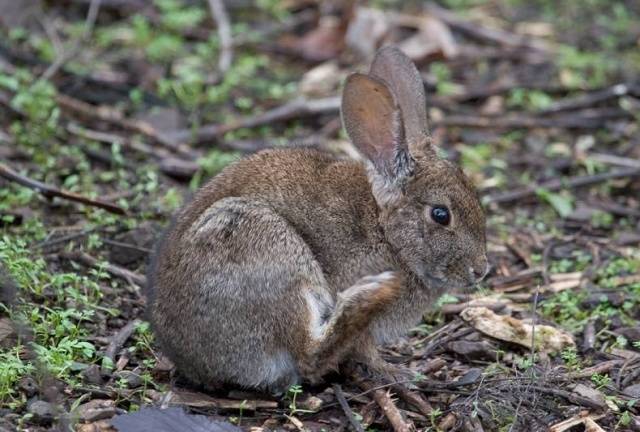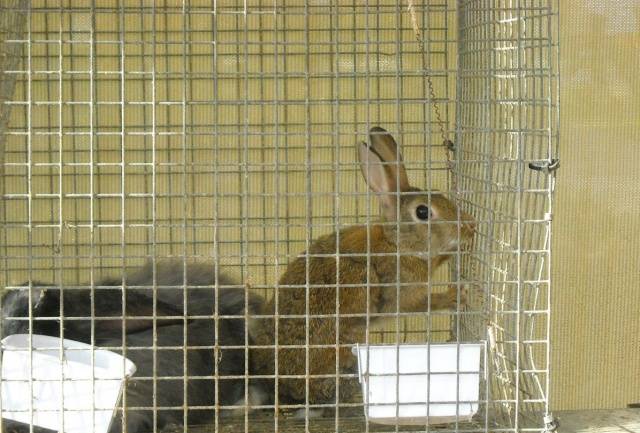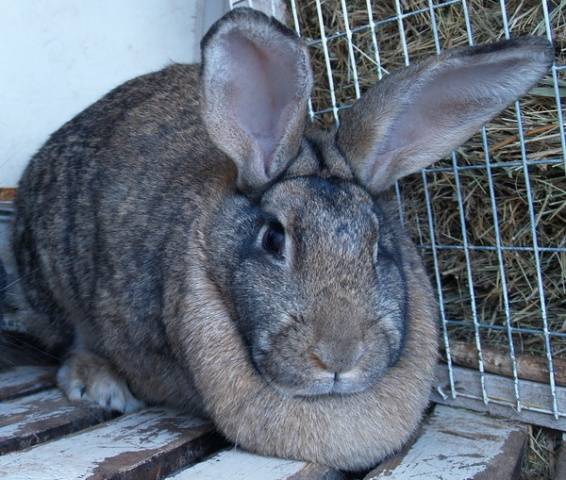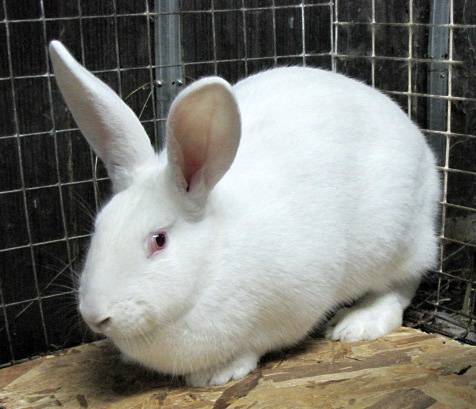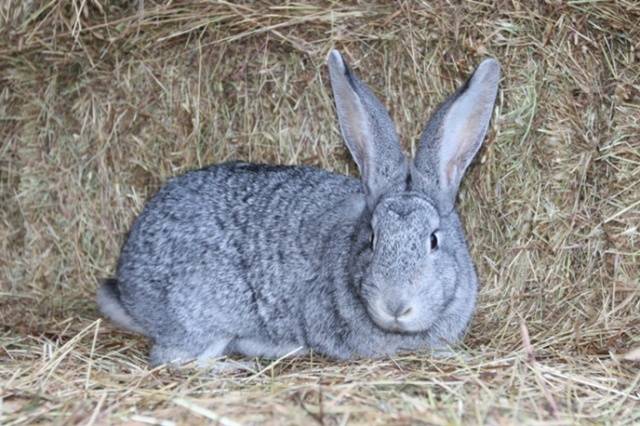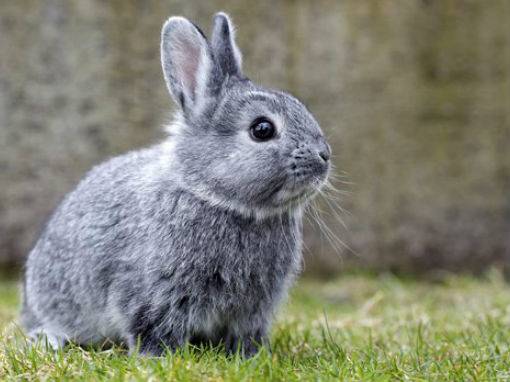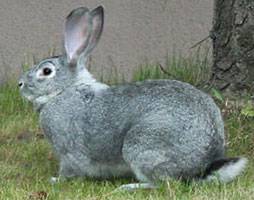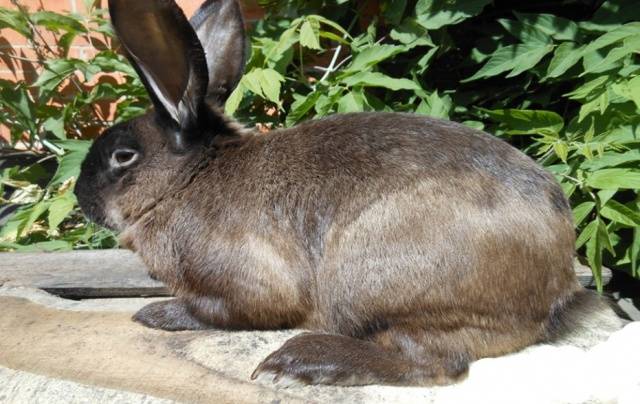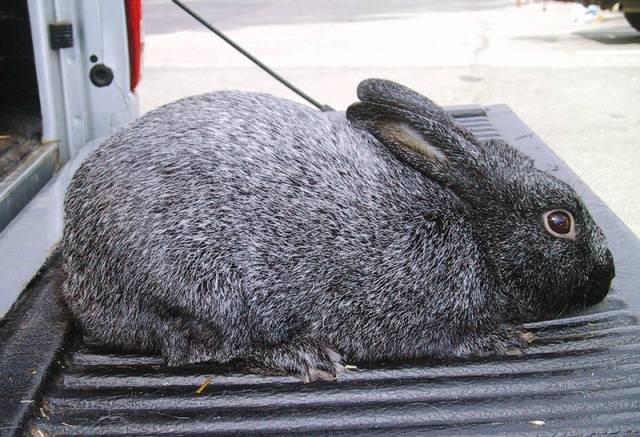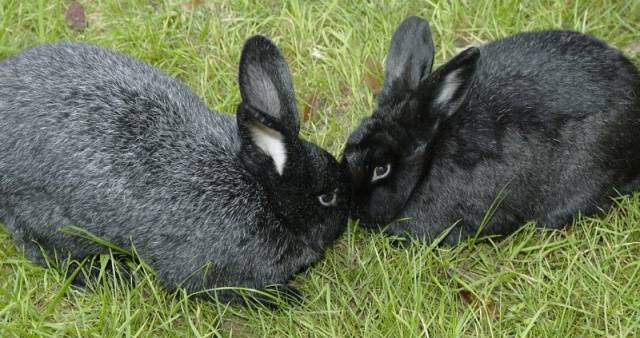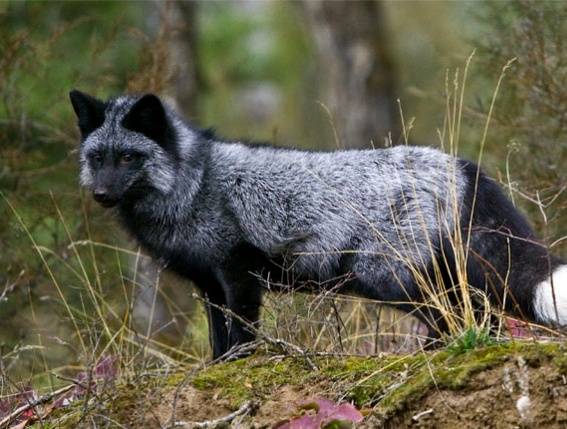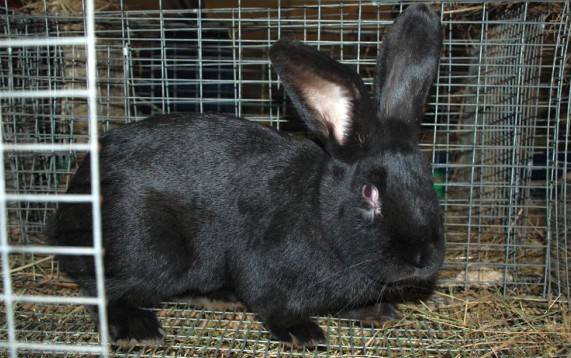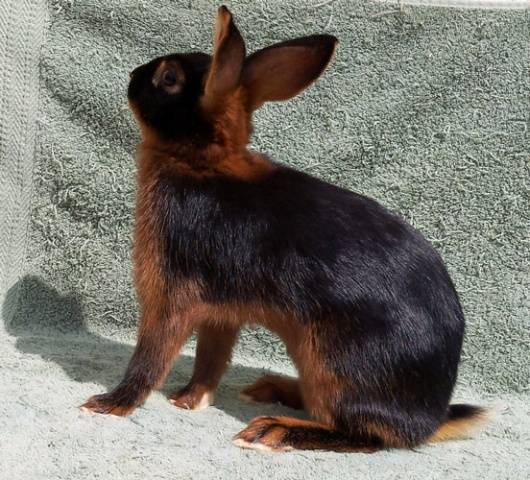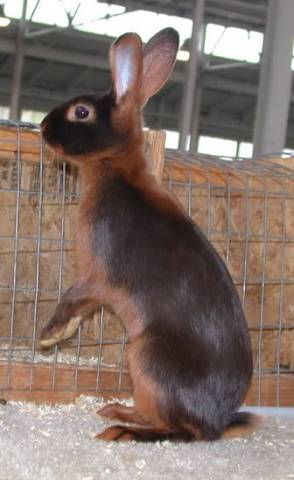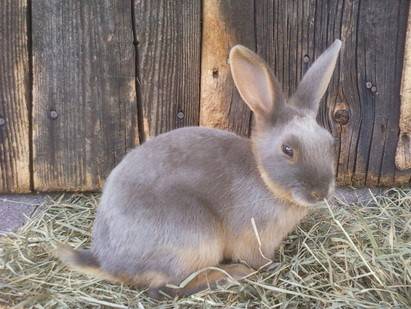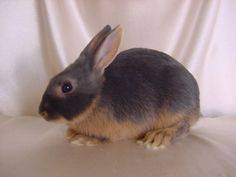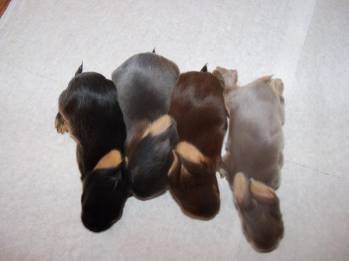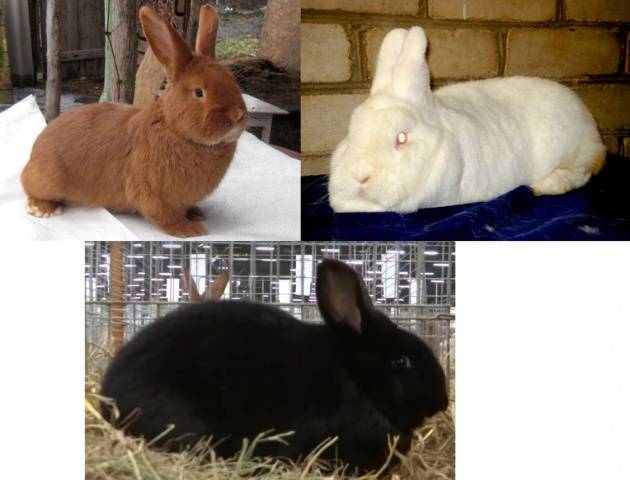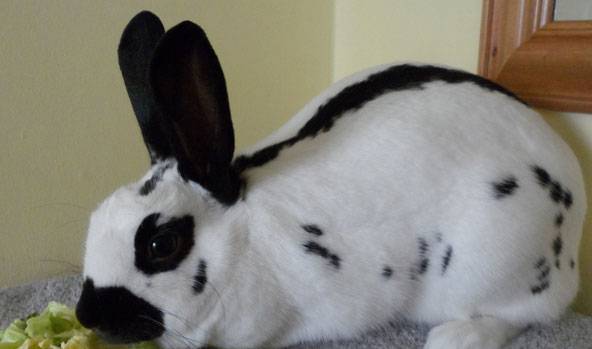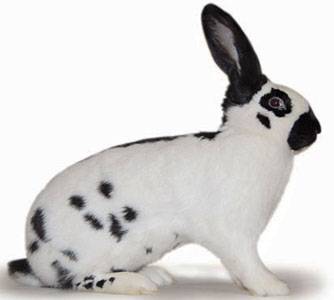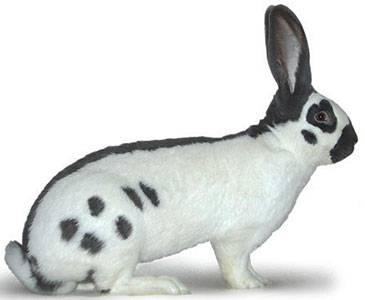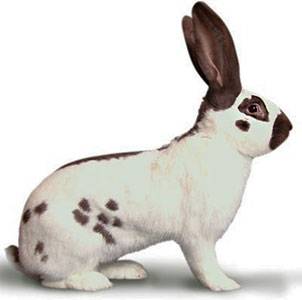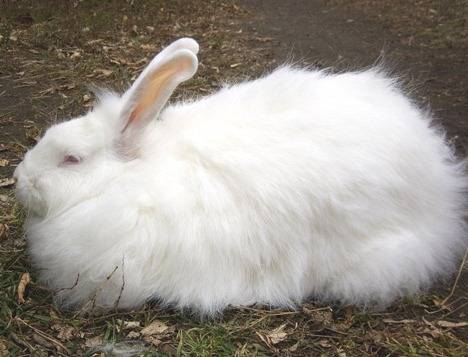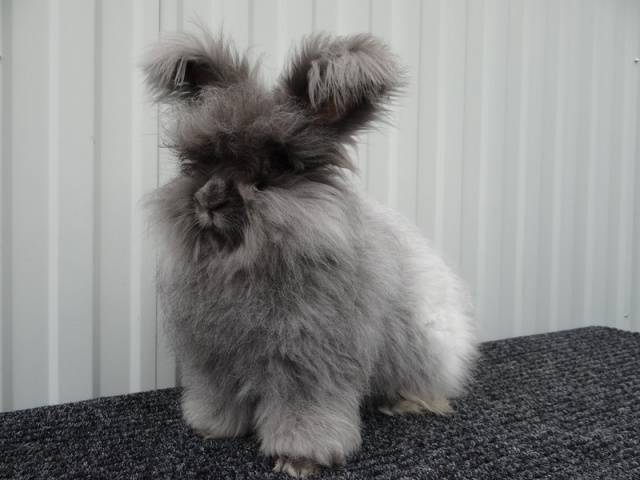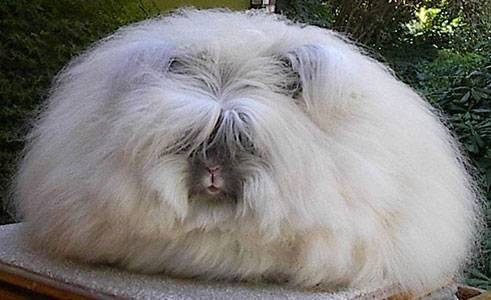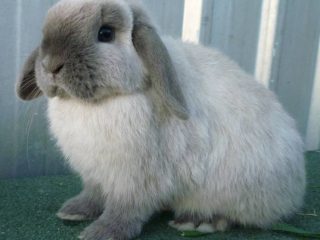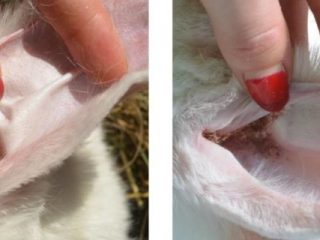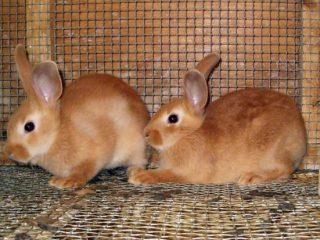Content
The wild European rabbit is one of the last domesticated animal species. The rabbit became a domestic animal about 1,500 years ago. Thanks to the rabbit's ability to reproduce early and quickly change generations, man has the opportunity to select animals for new characteristics, sometimes appearing during inevitable mutations.
In nature, animals with traits that interfere with survival are eliminated by natural selection. A person can preserve such a trait in a population of domestic animals if the trait is useful in human economic activity. And sometimes it's just a whim.
As a result of artificial selection, a single nondescript species of wild European rabbit gave rise to all the breeds of domestic rabbits that exist in the world today.
You can compare the wild rabbit on the right with a domestic one.
Even a small domestic rabbit is 2–3 times the size of a wild one. The exception is miniature rabbits, which can be smaller in size than their wild ancestor. But miniature rabbits have no economic importance. These are pets.
If you need not a pet, but a rabbit for meat, skin or fluff, then you need to decide on the breed.
Since the concept of “the best breeds of rabbits” is very relative, we will determine it by parameters. If we need rabbits to obtain high-quality wool, then the best would definitely be angora rabbit. If we need a large skin, then we need to choose one of the giant breeds. To quickly obtain meat, you need to choose among modern broiler breeds.
If possible, I would like to combine everything and at the same time have a minimum of hassle in setting up a rabbitry - you need to take a closer look at domestic breeds bred taking into account the climate.
Therefore, to begin with, it would be better to consider the breeds of rabbits bred in the USSR.
Breeds of rabbits bred in the Soviet Union
Considering a certain confusion on the Internet with images of rabbit breeds, the black-brown rabbit especially suffers from this, it is better to describe these breeds of rabbits with photographs, since, apparently, few people already know what the black-brown fox is, in “honor” which the black-brown rabbit breed was named for, and they constantly use photos of the English fiery-black rabbit as an example.
By the way, the fiery black has a very impressive color and this breed is also worth considering from the point of view of breeding in your own backyard. But later.
Rabbits in the USSR were bred taking into account climatic conditions. Soviet breeds include:
- white and gray giants, descended from European giant breeds with the infusion of blood from local hardy, but outbred animals;
- the Soviet chinchilla, which was also forced to be improved by local rabbits, since the European chinchilla was not adapted to the Russian climate;
- Soviet marder, a product of crossing already bred Soviet breeds with crossbred rabbits having a blue color;
- silver rabbit, originating from French Champagne with an influx of local blood;
- Russian Gornotaya or Himalayan, the origin of which is actually vague;
- black-brown, undeservedly forgotten, although it is one of the best breeds bred in the USSR.
All Soviet breeds have a meat-skin direction, being universal.
Gray giant
This breed traces its origins to the most famous giant rabbit in Europe - the Flanders rabbit. After Flanders brought to Russia, it turned out that he cannot stand Russian frosts. To eliminate this problem, Flanders were crossed with local rabbits, well adapted to the Russian climate.
The breed was officially registered in 1952. With some color variation in the colors of the gray giant, they all carry the wild agouti gene, most likely inherited from outbred animals. The color of the gray giant most closely resembles that of a hare with a gray or reddish tint.
A distinctive feature of a giant is also its ears when viewed from the front. They should be straight and form a Latin V.
The length of gray giants is 65 cm. Weight is up to 7.5 kg. But usually the average weight of female rabbits is 5 kg, rabbits 6 kg.
The advantages of the breed include the rapid growth of young animals. By 4 months, young rabbits already weigh 2.5 - 3 kg. Gray giants are more resistant to diseases than their whimsical ancestors, the Flanders.
One of the disadvantages is the low quality of the skin.The fur of the gray giant is not thick. But the skin is impressive in size - a third of a square meter.
White giant
Pure white pelt is highly prized in the fur industry as it can be dyed any color desired. At the same time, it is desirable that the skin itself be larger, since it is easier to work with a large skin when sewing fur products.
Based on the requirements of furriers, albinos began to be selected from Flemish rabbits. When importing white Flanders to Russia in 1927, breeders were faced with the problem of the heat-loving nature of Flanders.
Although the white Flanders rabbit appeared before the gray one, work on the breed White giant started much later. And the “late” gray giant and the French chinchilla rabbit were able to participate in its formation. If the gray giant as a breed was registered in the middle of the 20th century, then work on the white giant was carried out until the collapse of the USSR.
In order to improve endurance, the size of the white giant was “sacrificed.” It is smaller than gray, although not by much. The weight of the white giant ranges from 4.3 to 6.1. Average weight – 5 kg. Body length 60 cm with chest circumference 40 cm.
The white giant is fertile; a female rabbit has 7-10 rabbits in her litter. Queens of this breed rarely eat or trample their young. Rabbits gain weight well, reaching 2.5 - 3.5 kg by 4 months.
The skins of the white giant are in demand in industry, although they are inferior to the skin of the Soviet chinchilla. But chinchilla is gray, which limits the possibilities of using its skins.
One of the shortcomings of white giants is that they have weak hair on their paws, which is why they can get pododermatitis when kept on a slatted floor.
Soviet chinchilla
The Soviet Chinchilla was developed using a reproductive cross between French Chinchillas and the White Giant breed. In addition to crossing, there was a strict selection of rabbits based on size, adaptability to Russian climatic conditions and early maturity.
The resulting Soviet chinchilla is the largest of all Soviet breeds. The body length of the Soviet chinchilla is 70 cm, the average chest circumference is 40 cm. Weight is from 6 to 7 kg. At 4 months, Soviet chinchillas weigh 3.2 - 4.6 kg.
The color of rabbits of this breed, like all agoutis, is zoned gray.
Soviet chinchilla fur is of high quality. There is only one breed to which the chinchilla is inferior in terms of fur density. This is a black and brown rabbit.
The Soviet chinchilla is a versatile and very high-quality breed that produces excellent fur and tasty meat.
Soviet Marder
They were bred by crossing Soviet chinchillas with Russian ermines and then infusing the blood of outbred blue-colored Armenian rabbits. The result was an animal with completely unique fur, highly valued by the fur industry. The color of the rabbit resembles the color of the marten, which gave it its name. "Marder" is a marten.
Marder has a beautiful soft brown skin. The color range varies from dark to light brown. Due to the quality of the skin, the Soviet marder has very bright prospects for breeding these rabbits for the needs of the fur industry.
The rabbit itself is medium in size. Its weight reaches 5 kg. But it grows slowly, so it cannot be considered as meat.Meat in this case is a by-product.
Unfortunately, the Soviet marder is thermophilic and is unsuitable for breeding in the northern regions of Russia.
Silver rabbit
One of the situations when a new breed was bred without the addition of other blood, solely by selection. The parent breed of the rabbit is the French Champagne rabbit. It was bred in the Poltava region by selecting the largest individuals. During the breeding process, the previously unnoticeable silver color increased, and the breed’s resistance to climatic conditions improved.
The silver rabbit is raised not only for its beautiful skin. This breed is characterized by early maturity and produces tasty meat.
Silver rabbits are born black, sometimes gray. Silveriness gradually begins to appear after a month of life, and in a certain order: nose, tail, belly; head, back, chest, ears. This change in color in a certain order indicates the purebred of the animal. The animals finally bloom by 4 months.
In this case, from two parents of the same shade, the offspring will be lighter. When breeding, you should try to choose a pair so that one of the parents is darker than the other. The female rabbit brings 8-9 little rabbits.
Silvers resemble the Siberian squirrel not only in color, but also in temperament. These are cheerful and active animals that quickly get used to the staff.
Their average weight today is 4.5 kg. Maximum – 6.6 kg. At 4 months, the young already weigh 4 kg. The slaughter weight at 4 months is 60%, slightly short of the slaughter weight of broiler breeds.
Although the skins are valued for their fur, the fur is inferior in thickness to the Soviet chinchilla and the black-brown rabbit.
Russian ermine
Is the ancestor of the broiler California rabbit, which is so similar to the ermine that they are easily confused. The Russian ermine is also called the Himalayan.
The ermine originates from the Himalayas. Later the breed came to England, where it finally took shape as an ermine. The name of the breed was given due to the similarity of its color to that of an ermine.
The part of the population brought to Russia became larger during the breeding process and acquired a number of specific qualities, which gave reason to call the Russian part of the population the Russian ermine rabbit.
To increase body weight, stoats were infused with the blood of a white giant. As a result, body weight increased and the quality of fur deteriorated, while ermines were famous for their good fur. Further breeding work was aimed at returning the quality of the skin to the Russian ermine.
Currently, the average weight of Russian ermines is 3.8 kg. Body length 51 cm.
The female rabbit gives birth to 8 cubs, which are born completely white, acquiring their characteristic color only by 8 months.
The Russian ermine produces delicious, tender meat and excellent thick fur, which has virtually no analogues in quality in the world.
Black-brown
An undeservedly forgotten and already rare breed. But in vain. The black-brown rabbit is almost ideal for Russian conditions. They decided to breed this breed in the forties of the 20th century, when black-brown fox fur was in fashion. At the same time, work began on a breed of rabbits whose color could completely copy the black and brown fox.
An inexperienced person will certainly confuse a black-brown rabbit with a silver one.Apparently, this is why the description of black-brown usually does not coincide with the attached photograph. And with the correct description of the color of the black-brown rabbit, in the photograph you can see an animal with a black back and a red belly. These are two different rabbits. Black and red comes from England and is called black and fiery, its description is below.
But the silver breed does not have the veil that distinguishes the skin of the black-brown fox and the appearance of which was achieved in the black-brown rabbit. Although the black-brown was bred using the same Champagne breed and English silver.
In 1948, the black and brown was recognized as a breed with the following characteristics:
- average body length 60 cm;
- average chest circumference 30 cm;
- average weight 5 kg. Young animals at 8 months 3.5 – 4 kg;
The main color of purebred rabbits is black and brown.
For Russia, the black-brown breed is good because it is very unpretentious. Although the Californian broiler is ahead of the black-brown one in growth and slaughter yield, it is much more demanding and is not able to withstand Russian frosts.
There are two types in the breed. One carries the silver gene. The second should be pure black, but when viewed from different angles, the fur should become either light or brown - play. This quality is highly valued by furriers.
Unfortunately, after the collapse of the Union, the breed was almost lost. But it would be possible to sew “fox” sheepskin coats.
Black Fire Rabbit
A skin breed bred in England. There is not much meat from it, it is a by-product. And the live weight of the animal is 1.8 - 2.7 kg. But the original skin is used for sewing accessories and clothing. The American Rabbit Breeders Association standard provides 4 color options for this breed. What colors the black-and-fire rabbit has can be seen below.
Black.
Chocolate.
Lilac.
Blue
The difference in color is very noticeable in baby rabbits when they are close together.
Redhead is present in all color options.
Due to the original coloring and docile nature of this rabbit, today they are often bred as pets rather than as a skin breed.
Meat breeds
Broiler rabbit breeds in Russia today are represented mainly by the Californian and three varieties of the New Zealand breed.
These are medium-sized rabbits, characterized by rapid weight gain, early maturity and good skins.
Variations of the New Zealand rabbit breed, photo
Butterfly
The modern breed was formed in Germany, although there is also a dwarf variety of the butterfly.
The breed also goes by the names Strokach and German Pied Giant. The streak is a continuous dark stripe running along the entire spine of the butterfly.
The butterfly's spots come in three colors: black, blue and chocolate or havana.
Black.
Blue.
Havana.
A butterfly is a large animal. Body length is 66 cm, adult weight is from 6 kg. Young animals at 3.5 months - 2.7 kg. They grow a little slower than broiler rabbits.
The slaughter yield of meat is quite low, lower than that of silver - 55%. The butterfly also has good fur.
Downy breeds
In addition to meat and skins, some breeds can be used to obtain wool for yarn. During the molting period, these animals are literally skinned, collecting the falling fur.
White down
In the white downy coat, the amount of fluff in the wool is 84–92%, awns 8–16%. From an adult animal you can collect 350 - 450 g of fluff.And if you try and feed him well, then all 600 g.
The weight of adult white downy individuals is small, about 4 kg.
The white downy one does not tolerate heat very well. At temperatures above 28° he may die from heatstroke. Special cages have been developed for downy rabbits, suitable for keeping animals at any time of the year.
It is better to comb baby rabbits with a slicker brush so as not to frighten them with the plucking procedure.
Angora down
The breed originates from Turkey and is the parent of the White Powder. Angoras are bred for the purpose of obtaining fluff. You can also get other products, for example, meat, from them; the weight of representatives of the breed is 4 kg. But this is not profitable. The meat costs the same or cheaper than the meat of broiler animals, and you won’t be able to get any more fluff from a slaughtered animal.
The wool from the Angora is removed once every 3 months, obtaining up to 200 g of wool from one haircut or plucking.
When breeding for a tribe, animals with maximum hair growth are left. The rest of the young animals are stripped of their fluff twice and slaughtered for meat.
There are 6 varieties of Angora down breed:
- English;
- French;
- German;
- gigantic;
- satin;
- white (and colored).
Unfortunately, with the development of the production of artificial materials, the importance of rabbit fluff for industry began to decline. It may very well be that soon fluffy bunnies will only be seen in the zoo.
Conclusion
The rabbit breeder will need to decide which breed of rabbit to choose for breeding on a farm.But if you don’t want the extra hassle of setting up a warm rabbitry and finding the necessary feed, it’s better to take a domestic breed, which was bred at one time to meet the needs of the national economy of the USSR, where, frankly speaking, the animals were not pampered with high-quality feed.
